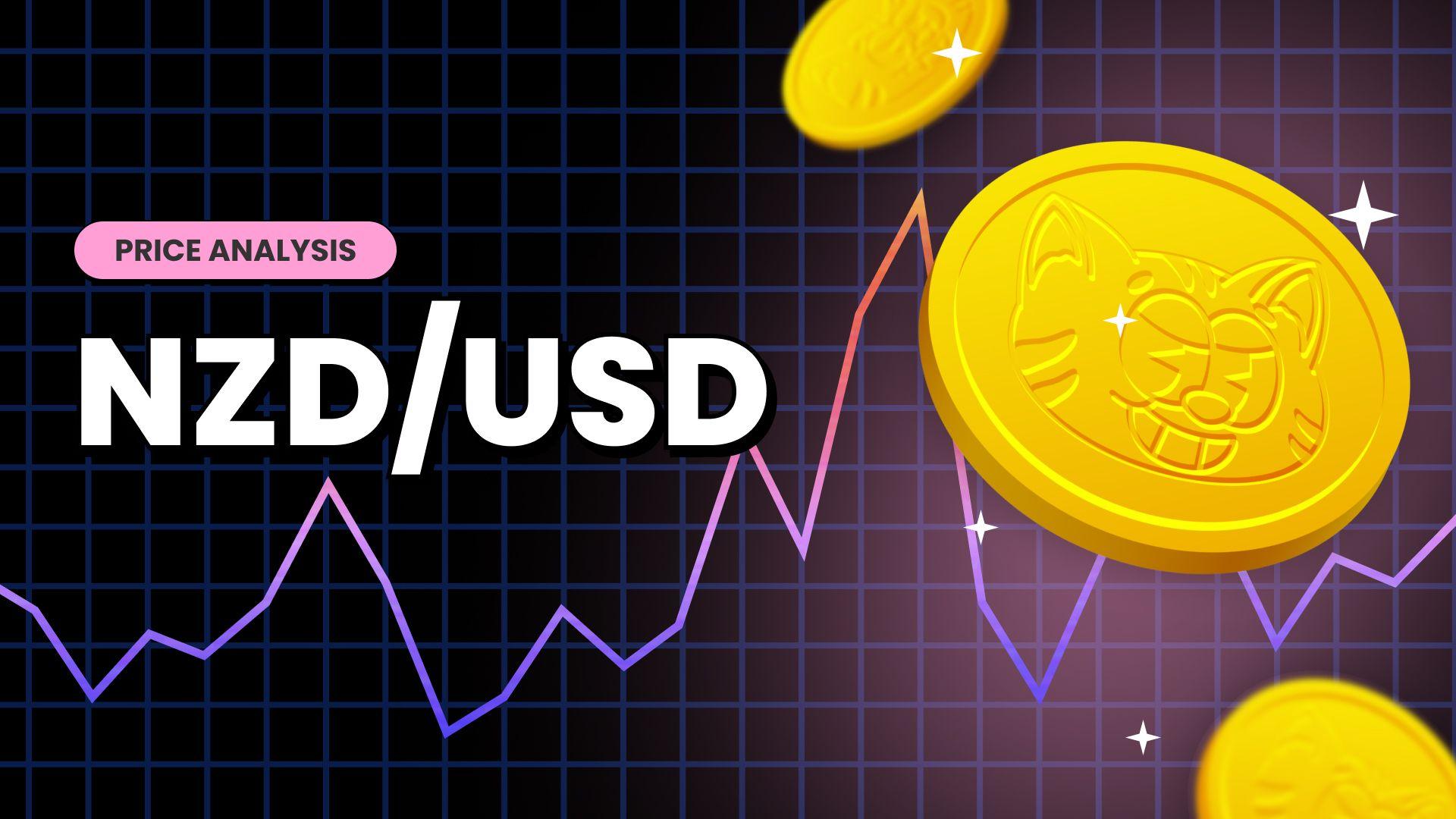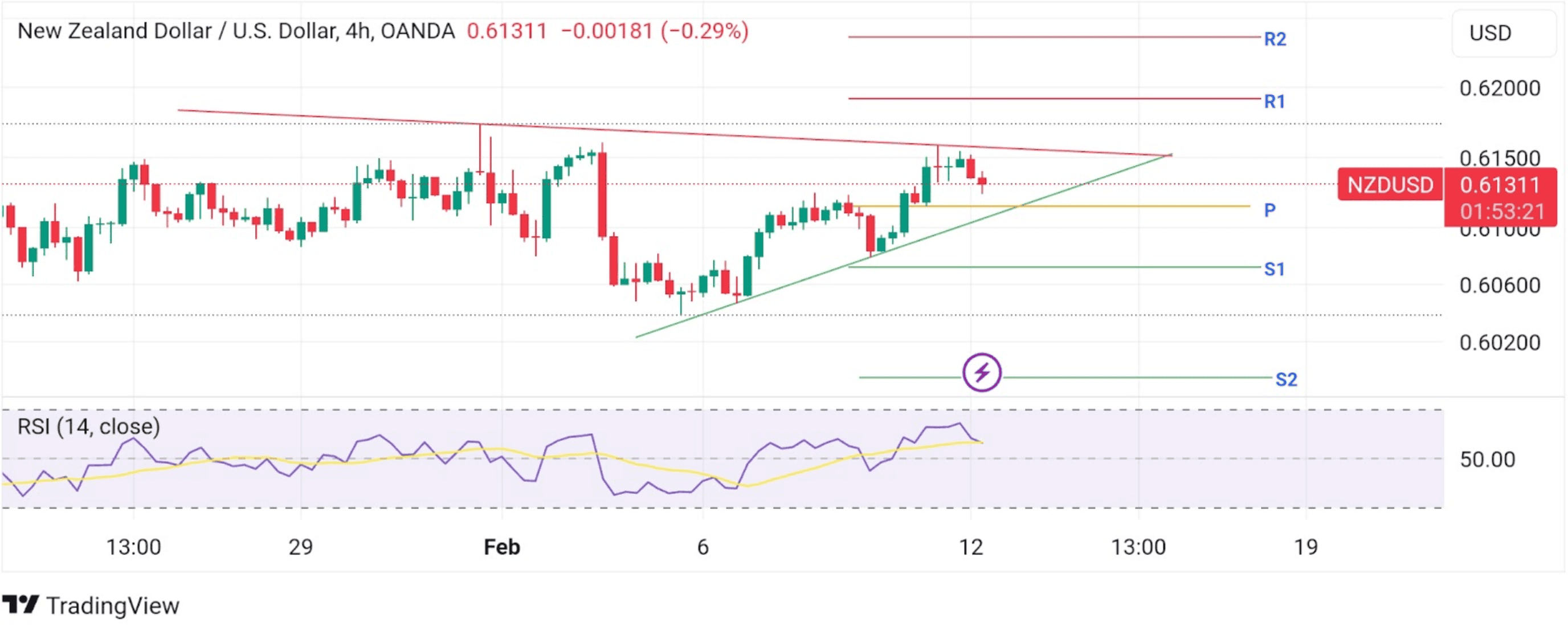NZD/USD Moves Back Towards 0.61300 Mark After Rejection From Key Resistance Level, Focus Shifts Toward U.S. CPI Data






Key Takeaways:
- NZD/USD pair retreated toward the 0.61300 mark on Monday during the Asian session
- Modest U.S. dollar strength was a key factor that helped limit further gains around the NZD/USD cross
- Deflationary risks weighing on China undermine the Kiwi
- Markets' attention shifts toward releasing key U.S. inflation data on Tuesday
The NZD/USD cross attracted some selling on the first day of the week, capitalizing on the modest bounce from the vicinity of the 0.61589 level or one-week high touched on Friday. As of press time, the shared currency is down over 18 pips for the day and looks set to maintain its offered tone heading into the European session.
The ongoing rise in U.S. Treasury bond yields amid receding bets for aggressive early rate cuts by the Fed assisted the U.S. dollar in regaining strength despite weakening for the last four days. It was a critical factor that undermined the NZD/USD pair.
Markets seem convinced that the Fed will leave rates unchanged during the March meeting and start cutting rates during the third quarter of 2024 in the wake of fresh, robust U.S. data, which saw investors scale back further their bets on the timing of interest rate cuts.

Furthermore, the hawkish comments from a host of Fed speakers cautioning against aggressive early rate cuts further cemented market bets that the Fed would not cut rates during the March meeting. Fed Governor Adriana Kugler said that while inflation is easing, the "job is not done yet." In contrast, Minneapolis Fed President Neel Kashkari expects only two to three cuts.
The influential FOMC member's comments join the past two weeks' Fed Chair's comments, in which he poured cold water on a March rate cut and reassured markets that the central bank will proceed carefully with interest rate cuts this year and likely will move at a considerably slower pace than the market expects.
That said, CME's fed watch tool shows that fund futures traders have also priced in an 82.5% chance that the Fed will keep rates unchanged at 5.25% - 5.5% during the March meeting, with the first-rate cut now seen during the June meeting.
Further undermining the NZD/USD cross is the disappointing Chinese inflation report released on Thursday. It showed that China's consumer and producer prices declined in January, underscoring the deflation risks facing the world's second-largest economy.

Despite the combination of negative factors, the Kiwi continues to draw support from the Reserve Bank of New Zealand's (RBNZ) decision to rule out rate cuts until 2025 at the earliest, which might help limit further losses around the NZD/USD pair. RBNZ Governor Adrian Orr, appearing before a parliamentary committee on Monday, confirmed the central bank will continue to maintain a "restrictive monetary policy" position as inflation (the current inflation rate stands at 4.7%) is still way above the central bank's target band of 1% to 3%. "That's why we've retained a restrictive monetary policy stance with the official cash rate at 5.5% and we'll be back at the end of this month again with our updated views on the wisdom of that stance," Orr told lawmakers.
As we advance, in the absence of any significant market-moving economic news data, the Treasury bond yields and the general market risk sentiment will continue to influence U.S. dollar dynamics and ultimately provide directional impetus to the NZD/USD cross. The main focus, however, remains on Tuesday's release of U.S. consumer inflation figures, which might influence the Fed's future policy decisions.
Technical Outlook: Four-Hour NZD/USD Price Chart

From a technical standpoint, NZD/USD is trading with modest losses just below the 0.61300 level following an extension of the sharp bounce from the upper limit of the Bearish Symmetrical Triangle pattern and subsequent acceptance below the technically strong 200-day (yellow) Exponential Moving Average (EMA) at the 0.61391 level. A further increase in selling pressure would drag spot prices toward the 0.61153 level, which acts as a pivot level. A convincing move below this level, followed by a bearish price breakout below the lower limit of the Bearish Symmetrical Triangle pattern, would reaffirm the bearish bias and pave the way for dip losses around the NZD/USD pair. The NZD/USD cross could accelerate the downfall toward the 0.60721 support level (S1). If this level fails to hold, the NZD/USD price could decline toward the 0.60000 round mark route to the 0.59951 floor.
On the flip side, if buyers resurface and spark a bullish turnaround, initial resistance comes in at the 0.61391 level. Sustained strength above this level would negate the near-term bearish outlook and pave the way for an ascent toward the key resistance level plotted by a downward-sloping trendline extending from the late-January 2024 swing higher-highs (upper limit of the Bearish Symmetrical Triangle pattern). A clean break above this level would act as a fresh trigger for bulls to place new bids, paving the way for a rally toward the 0.61921 level (R1). If the price pierces this barrier, buying interest could gain further momentum, paving the way for a rally toward the 0.62362 ceiling.
Apart from this, the modest rebound in the U.S. equity markets also turned out to be another factor acting as a tailwind for the safe-haven greenback and helping cap the downside for the USD/CNH cross. Receding bets for aggressive early rate cuts by the Fed in the wake of fresh, robust U.S. data turned out to be a key factor underpinning Treasury bond yields. They assisted the NZD/USD pair attract some selling at lower levels.